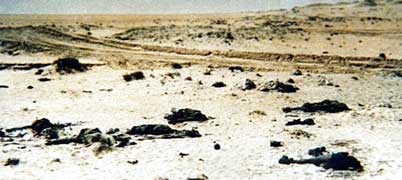| DU top | | home |
 CONTENTS:
CONTENTS:
| Gulf War veterans who fell ill due to radioactive
depleted uranium munitions fired by their
own comrades insist, "We were told nothing,"
about the danger of radiation. This echoes
the complaint of the vast numbers of American
soldiers who contracted cancer after participating
in the atmospheric nuclear testing conducted
from the late 1940s into the 1960s. DU munitions
are proliferating and being exported around
the world as conventional weapons. But what
sort of weapons are they? Why are so many
US soldiers being exposed to DU particles?
The following articles will use photos of
the Gulf War and its victims to demonstrate
the nature and effects of DU munitions.
(Akira Tashiro, senior staff writer)
|
 |
| Charred bodies Bodies of Iraqi soldiers abandoned in the desert. Charred black by fires ignited by depleted uranium projectiles, they look all too familiar to those of us who have seen the A-bomb Memorial Museum in Hiroshima. (Courtesy of Carol Picou, taken February 1991 in southern Iraq) Click to view larger picture (54K) |
| What is DU? |
Natural uranium ore from the mine goes through an enrichment process designed to separate uranium 235 (U-235), the isotope used for nuclear weapons and nuclear reactors, from uranium 238 (U-238), a low-level radioactive by-product. The highly radioactive isotope U-235 accounts for less than 1% of mined uranium; nearly all the rest is U-238.
The vast quantity of highly toxic metal (U-238) generated by this process is called "depleted uranium" or "DU." DU emits primarily alpha radiation, and its half-life is thought to be about the age of the Earth, or 4.5 billion years.
DU began accumulating in the US in the early 1940s while the Manhattan Project was developing the first atomic bombs. To date, more than 500 thousand tons have been produced, and it continues to accumulate. At the uranium enrichment plant in Paducah, Kentucky, and two other locations, DU is packed into metal containers and stored outdoors.
DU is approximately 2.5 times denser than iron and 1.7 times denser than lead. This high specific gravity means that, as a projectile fired from a tank or aircraft, it carries enough kinetic energy to blast through the tough armor of a tank. Furthermore, the impact of this penetration generates extreme heat. DU is pyrophoric, meaning that it burns on impact and can set the target on fire. DU is easy to process and endless quantities can be obtained free from the Department of Energy (DOE), which controls DU and considers its use in munitions to be "utilization of waste material."
The US military first noted these advantageous features of DU in the 1960s, at the height of the Cold War. It began working with such institutions as the Los Alamos National Laboratory (New Mexico) to develop DU armor piercing shells for use against the tanks of the former Soviet Union. Production began in the 1970s and 1980s at a number of military munitions factories. The weapons are tested at several firing ranges around the country.
 |
| Graffiti on a punctured armored vehicle Holes punched by DU penetrators are clearly visible in this US Bradley armored vehicle mistakenly destroyed by friendly fire. The graffiti on the vehicle speaks for itself. (Courtesy of Jerry Wheat, taken February 1991 in southern Iraq) Click to view larger picture (19K) |
The US military first used DU munitions in combat during the Gulf War, firing penetrators from 120 and 105mm canons mounted on tanks. Aircraft fired them from 25 or 30mm guns. The British fired DU rounds from tanks only. During Operation Desert Storm (February 24 to 28, 1991), at least 10,000 rounds of DU ammunition were fired from tanks, and at least 940 thousand were fired from aircraft.
A DU projectile from a 120mm canon weighs about 10.5 pounds (about 4.7 kilograms). One from a 30mm gun weighs about 0.67 pounds (about 300 grams). Because they burn on impact, 20 to 70% of their mass is vaporized and diffuses into the air as uranium oxide particles. It is said that when these uranium oxide particles are ingested or inhaled, the combination of radiation and high chemical toxicity can cause cancer and a wide variety of other ailments.
The US Nuclear Regulatory Commission (NRC) has set the permissable internal dose of U-238 at 0.19 milligrams per day for the general public. For employees at nuclear-related facilities, the limit is 2 milligrams.
| DU top | | home |